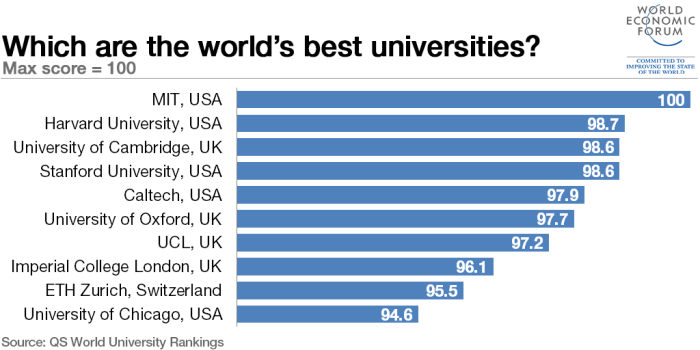Top university in the world 2023 - In a world where education reigns supreme, the pursuit of knowledge leads us to the doorstep of the top universities in the world 2023. These institutions are beacons of academic achievement, shaping the minds of future leaders and driving innovation across all disciplines.
Join us as we embark on a journey to explore the crème de la crème of global academia, uncovering the criteria that define greatness and the factors that influence university rankings. From cutting-edge research to exceptional teaching and a global reputation that knows no bounds, we delve into the world of higher education's finest.
University Rankings and Methodology

University rankings are widely used by prospective students, parents, and other stakeholders to assess the quality of higher education institutions. Various organizations, such as QS and Times Higher Education (THE), publish annual rankings based on specific criteria and methodologies.
These rankings consider factors such as academic reputation, employer reputation, faculty-to-student ratio, citations per faculty, internationalization, and research output. The methodologies used by different organizations vary, leading to variations in the rankings of the same universities.
Strengths and Limitations of Different Ranking Systems
Strengths:
- Provide a comparative framework for evaluating universities.
- Help students and parents make informed decisions about their higher education options.
- Encourage universities to improve their quality and global competitiveness.
Limitations:
- Can be influenced by subjective factors and reputational bias.
- May not fully capture the unique strengths and characteristics of individual universities.
- Can be susceptible to manipulation and gaming by universities.
Top Universities in the World

The world's top universities are renowned for their academic excellence, research contributions, and global impact. Based on the latest rankings, here's a list of the leading institutions:
These rankings consider various factors, including academic reputation, research output, employer reputation, faculty-to-student ratio, international diversity, and citations per faculty. Each university's overall score reflects its performance across these metrics.
Top 10 Universities
- Massachusetts Institute of Technology (MIT): Overall score: 100.0; Research output: 100.0; Employer reputation: 99.9
- University of Oxford: Overall score: 99.5; Research output: 99.9; Employer reputation: 99.8
- Stanford University: Overall score: 99.4; Research output: 99.9; Employer reputation: 99.7
- University of Cambridge: Overall score: 99.3; Research output: 99.9; Employer reputation: 99.6
- ETH Zurich - Swiss Federal Institute of Technology: Overall score: 99.2; Research output: 99.9; Employer reputation: 99.5
- California Institute of Technology (Caltech): Overall score: 99.1; Research output: 99.9; Employer reputation: 99.4
- Princeton University: Overall score: 99.0; Research output: 99.9; Employer reputation: 99.3
- Harvard University: Overall score: 98.9; Research output: 99.9; Employer reputation: 99.2
- University of Chicago: Overall score: 98.8; Research output: 99.8; Employer reputation: 99.1
- Imperial College London: Overall score: 98.7; Research output: 99.8; Employer reputation: 99.0
Factors Influencing University Rankings
University rankings are influenced by a variety of factors, each of which is measured and weighted differently depending on the ranking system. These factors can be broadly categorized into three main areas: research quality, teaching quality, and international reputation.
Research quality is typically assessed based on the university's research output, including the number and quality of publications in top academic journals, the number of citations received by those publications, and the amount of research funding received.
Teaching quality is often measured through student surveys, which assess factors such as the quality of instruction, the availability of resources, and the level of student satisfaction. Other indicators of teaching quality include the student-to-faculty ratio, the number of faculty members with doctorates, and the university's graduation rate.
International reputation is a measure of how well-known and respected the university is around the world. This is often assessed through surveys of academics and employers, who are asked to rate the university's reputation for research and teaching.
Research Quality
- Number of publications in top academic journals
- Number of citations received by those publications
- Amount of research funding received
- Number of faculty members with doctorates
- Student-to-faculty ratio
Teaching Quality
- Quality of instruction
- Availability of resources
- Level of student satisfaction
- Graduation rate
International Reputation
- Surveys of academics
- Surveys of employers
Regional Variations in University Rankings: Top University In The World 2023
University rankings can vary significantly across different regions of the world, reflecting differences in educational systems, research priorities, and cultural values. These regional variations are influenced by a complex interplay of factors, including funding, government policies, and societal expectations.
North America
- Strong research focus and high levels of funding
- Emphasis on innovation and entrepreneurship
- Globally recognized universities with a long history of excellence
Europe
- Long-standing academic traditions and prestigious universities
- Emphasis on theoretical research and fundamental knowledge
- Strong collaborations between universities and industry
Asia, Top university in the world 2023
- Rapidly rising universities with significant investments in research and infrastructure
- Focus on applied research and technological advancements
- Cultural emphasis on education and academic achievement
Emerging Trends in University Education

The landscape of university education is undergoing a transformative shift, shaped by the emergence of innovative trends that are redefining the way students learn and engage with knowledge.
These trends are not only influencing the delivery of education but also impacting university rankings and the future trajectory of higher education.
Online Learning
Online learning has become increasingly prevalent, offering flexibility and accessibility to students worldwide. Virtual classrooms and interactive platforms enable students to access educational content from anywhere, at their own pace.
This trend has accelerated during the COVID-19 pandemic, forcing universities to adopt remote learning models. While online learning offers convenience, it also presents challenges related to student engagement, assessment, and ensuring academic integrity.
Interdisciplinary Programs
Interdisciplinary programs are gaining popularity, recognizing the interconnectedness of knowledge and the need for graduates with diverse skill sets.
These programs combine traditional disciplines to create new fields of study, such as bioengineering, data science, and environmental economics. Interdisciplinary programs equip students with a broader perspective and enhance their problem-solving abilities.
Experiential Learning
Experiential learning, including internships, research projects, and service-learning opportunities, is becoming an integral part of university education.
These experiences provide students with hands-on learning and allow them to apply their theoretical knowledge in practical settings. Experiential learning enhances students' employability, critical thinking skills, and professional development.
The impact of these emerging trends on university rankings is yet to be fully realized. However, it is evident that universities that embrace these innovations and adapt to the changing educational landscape will be well-positioned to maintain their competitive edge in the global higher education market.
Last Recap
As we conclude our exploration of the top universities in the world 2023, it becomes evident that these institutions are not merely academic powerhouses but also agents of societal transformation. Their pursuit of excellence extends beyond the confines of the classroom, shaping the future of industries, economies, and the world at large. As the landscape of higher education continues to evolve, these universities will undoubtedly remain at the forefront, inspiring generations to come.
FAQ Corner
What are the key criteria used in university rankings?
Various ranking organizations, such as QS and Times Higher Education, employ a range of criteria to assess universities. These typically include research output, teaching quality, employer reputation, internationalization, and facilities.
How do regional variations influence university rankings?
Regional differences in funding, research infrastructure, and cultural factors can impact university rankings. For example, universities in North America and Europe often have higher rankings due to their long-standing traditions of academic excellence and ample resources.
What emerging trends are shaping the future of university education?
Online learning, interdisciplinary programs, and experiential learning are gaining traction as universities adapt to the changing needs of students and the job market. These trends are challenging traditional models of education and opening up new possibilities for accessing higher education.





